Fomitopsis pinicola
Fomitopsis mounceae
Saprotrophic
Musical Taxonomies
*The mushroom commonly referred to as Fomitopsis pinicola in North America has been reclassified as Fomitopsis mounceae.
Pinicola now refers exclusively to the European species. The fungus’ spitting image found in North America genetically differs enough to require its own species classification.
Because I began writing this article when it was still known by its former name, this article lists pinicola as a species name, primarily because that is still the commonly used name. I want more budding mycologists to be able to find it in a search. For, as mushroom-informed as I am, I stumbled a bit when I first started finding articles about Fomitopsis mounceae, thinking I had gotten lost in a taxonomical labyrinth. This has become a familiar feeling while digging through mycological research. It’s a feeling that’s disheartening enough to the fungal curious that I wanted to address it here:
As a self-taught amateur mycologist, I want to create a safe place here to learn. Please know you can ask me any questions in the comments, and I will answer without condescension. The mycological world is full of gatekeepers who will talk down their nose at you if you fumble a species name or you’re not up to date on the most recent genetic research. Trust me, our knowledge about fungal life expands so rapidly that it’s impossible to remain up to date.
Humbly, I will accept corrections and encourage discussion. If you know something I don’t about a mushroom I’ve written about, let’s talk about it.
Irene Mounce
Excitedly, I learned that the newly pheno-typed specimen was collected in my home province. Irene Mounce, a Canadian mycologist, removed the fateful conk from a poplar tree near Edson, Alberta.
I feel a sense of vicarious pride that this distinct species was named after a woman. The field of mycology, even at the amateur and applied level, is very male dominated, and I frequently feel alone. Not everything is about gender, but sometimes it is.
Presumably, mushrooms are genderless, or multi-gendered. A single fruiting of a cluster of mushrooms can contain both sexual and asexual spores, and both male and female reproductive structures. More on this later. At the risk of anthropomorphizing, to make them more approachable, I have gendered individual mushrooms in this publication. Because an aspect of my mission in writing A Mythology of Mycology aims to quell mycophobia, anything I can do to make these anomalous beings more relatable is fair game.
Fomitopsis mounceae, named as it is after a woman and shaped in an elegant curve; displaying fiery red strips and arcing from the trunks of trees gracefully, well, she’s a woman. Henceforth to be referred to by the feminine pronouns.
Now I will get out of the way and let this powerful being speak through me.
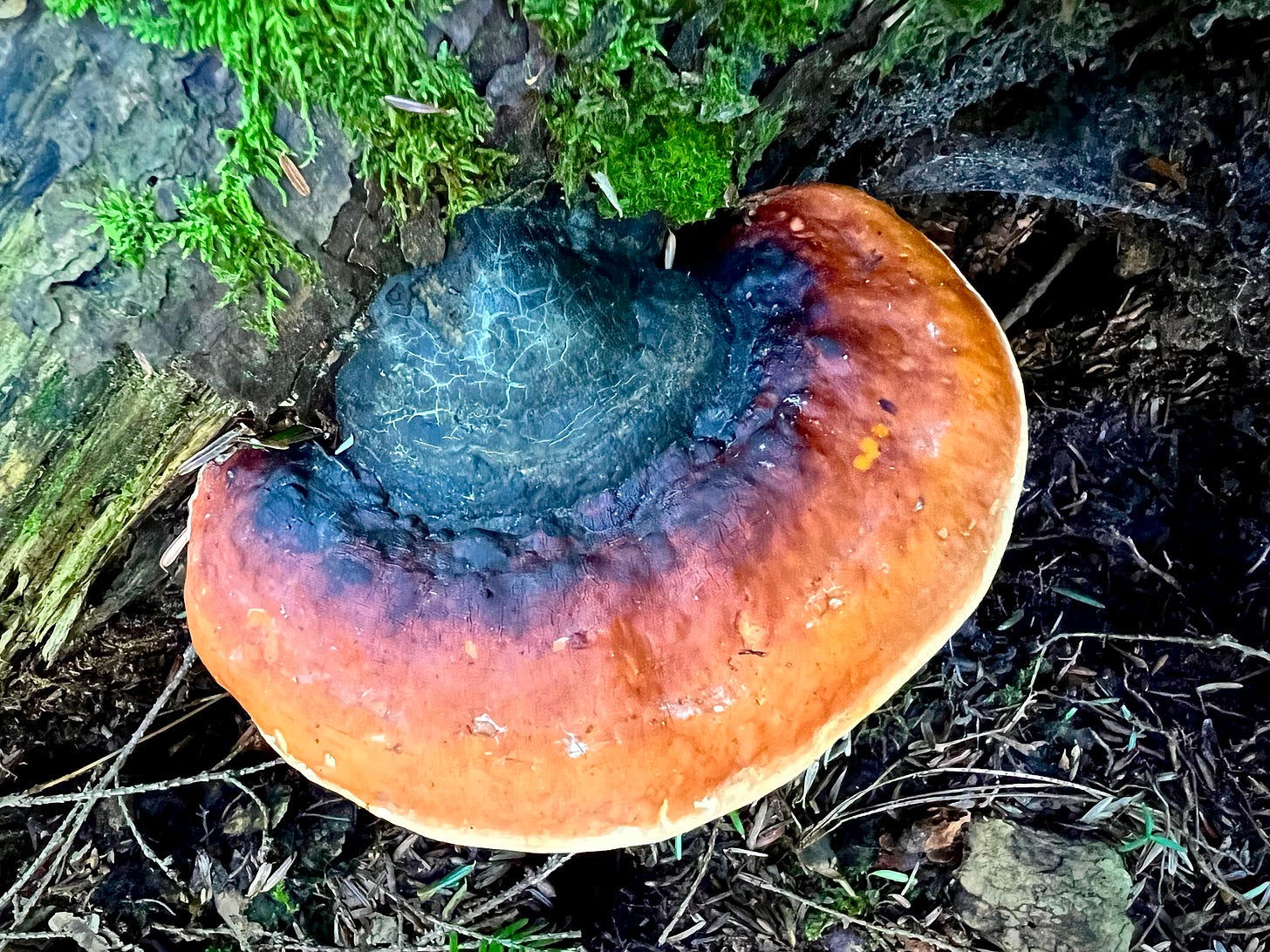
A League of Her Own
Frequently paired and compared with her famous friend, reishi; often mentioned in the same breath as her famous cousin, amadou - renowned for its affiliation with the Ice Man mummy - this character deserves a fame of her own.
It’s fair that she’s frequently associated with reishi, because their medicinal offerings are markedly similar. As well, they are often listed as each others’ look-a-likes on foraging blogs and field guides. They are both red, hoof-shaped conks, but the similarity ends there. Reishi has a stem, red belted attaches directly to the tree-trunk. Reishi has a white pore-face, red belted has a creamy visage. Reishi shines as though varnished, red belted glows matte ochre in the dim forest light. As for their similar medicinal arsenals, you’ll learn about that as you read on.
Our dear red belted is in danger of being eclipsed by reishi due to the sheer amount of research that has been bestowed upon the other. For thousands of years, reishi has been the darling of Chinese medicine.
I have even heard red belted polypore referred to as North American reishi. I don’t think she’d be offended by the comparison, reishi is a queen among fungus, and will receive a chapter of her own in this very tome. However, I believe red belted deserves her own legions of adoring fans and informative literature.
We could easily order a big bag of reishi online. There’s dedicated reishi farms and teams of foragers all across Asia to support the rising demand. But, as always, when a crop becomes too popular, there’s issues with over-harvesting wild mushrooms. Further, once something becomes a cash crop, inequalities arise around local people’s access to affordable supply.
I’m always of the opinion that we use what’s locally available to us. For several reasons:
We know where it came from. We know if it was sustainably harvested, especially if we harvested it ourselves. Also, studies show that local medicinal mushrooms have developed metabolites to fight off the bacteria, fungi, and viruses that threaten organisms in its vicinity. She grows in locales near to us, exposed to many pathogenic microbiota that we will encounter in our daily lives.
Wonderfully widespread and easy to identify, this burgundy beauty’s range meanders across most of North America. She’s growing on a tree near you, waiting to be found.
In Canada, where winter spans nine months of the year – enough time for the gestation of a human – it is a treasure to find this fungal presence in the snow-coated or rain-soaked woods. They provide mushroom fanatics like me with a foraging target in the winter months.
Conveniently, early winter is also the best time in the mushroom’s life cycle to harvest. Like plants, fungus can be perennial or annual. Red belted polypore is perennial. For the non-gardeners, that means they grow continually instead of dying back before fruiting again. Their bodies are perpetual, eternal. For this reason, conks are among the most comforting and familiar of the fungal kingdom. And humans have trusted them with our health and our precious fires for thousands of years.
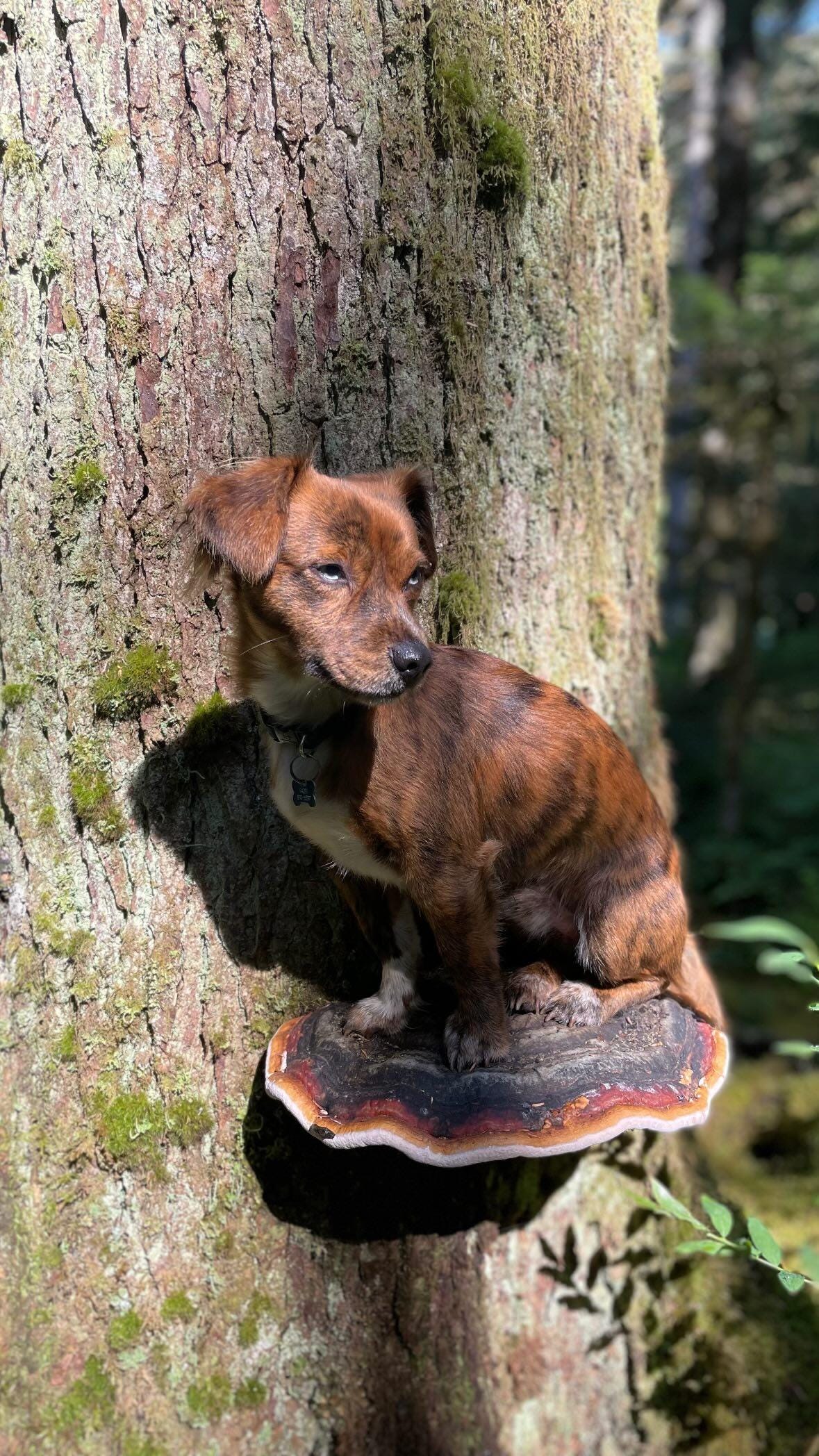
Terminology
The reason she’s so often mentioned alongside amadou is that they are both in the genus Fomes and are documented for the same traditional uses. The name for the genus originates from the Latin word meaning tinder. This genus appears throughout human history as a method our nomadic ancestors used for carrying the fire between camps. Too deep a story to unpack here, I’ll delve into this in the chapter on Amadou.
Pinicola refers to this conk’s preferred substrate. Red belted is among the saprophytic alchemists: turning decay into their own cell walls. Its mycelium causes brown rot in trees and is frequently found breaking down the long bodies of conifers. She particularly likes devouring hemlock, pine, and spruce, but doesn’t discriminate and will readily be found on the backs of birch, aspen and other hardwoods. Misleadingly, since the name implies relation to a tree, she’s one of the rare conks that isn’t easily identified using the tree species that she grows on. Luckily, she has a distinct look.
Stratification and Guttation
Guttation – A mycological process whereby the mushroom exudes droplets of excess water. I remember this word by picturing the mushroom gluttonously slurping up rainwater. The same way humans slurp champagne on New Years Eve or beer on Superbowl Sunday. We then have to sweat it out. Just like us, when they’re glutted on liquid, they guttate.
It’s a beautiful sight to come across. If you look closely, you’ll glimpse the forest held in reverse and miniature inside each glistening globe. I recommend sipping the droplets from this mushroom’s belly. Bittersweet, earthy resin, mushroomy musk, bouquet of the woods trickling down your throat.
This is a process unique to polypores and most commonly witnessed on red belted. Annual mushrooms will engorge to the limits of water available to them. Perennial polypores grow more like trees, achingly ring by ring. They must have a way to pass on water that they can’t use right away. Hence, guttation. Another one of the many ways mushrooms remind us of ourselves.
Stratification – In a geological sense, this term simply means layering. Perennial conks that grow in rings display this delicious layer cake pattern. A pattern pleasing to the eye and mind, visual evidence that life goes on. Reminders that we do not stand alone. That we build on what’s come before us, and that others will build on what we’ve created in our fleeting lives. It’s comforting.
But then, humans always have to make it weird, don’t we?
Alongside geological stratification, the slow building of solid structures of stone and earth, the term social stratification appears in the online dictionary. Just like that, our flimsy social strata are forever associated with the stability of mountain and glacier. A reminder that changelessness is an illusion.
Here’s what Wikipedia says:
“Social stratification refers to a society's categorization of its people into groups based on socioeconomic factors like wealth, income, race, education, ethnicity, gender, occupation, social status, or derived power. It is a hierarchy within groups that ascribe them to different levels of privileges. As such, stratification is the relative social position of persons within a social group, category, geographic region, or social unit.”
The first example of social stratification in action is slavery.
I’m just going to let that sentence stand on its own. Thankfully, we are at a point in time when the majority of people believe that enslaving other humans is ethically wrong. We got to this place by making horrendous mistakes and learning from them. May we continue to learn and grow. Unlike some, I don’t believe humanity is hopeless.
Kokum* used many moments to teach us young ones lessons about not taking too much. About appreciating what we have and sharing with one another. She once broke up a fight over a box of Gushers. She marched us out, lecturing all the while that we were behaving greedily, ungrateful and entitled. As we slid the coveted box into the food bank donation slot, she said “no-one is wealthy until we’re all wealthy.”
Those words have echoed through my life.
Recently, they’ve surfaced with regards to wars and famine. The phrase is this: “No-one is free until we’re all free.” The sentiment is the same. We are all connected. A network more delicate than the mycelial threads that link all terrestrial life through the wood wide web. We were connected in this way long before the internet. Now we can watch in horror as atrocities are inflicted on other humans and plots of land. We’ve always sensed it; now, we can see it in real time. And it’s heartbreaking.
We are growing together. I truly believe this. Layer upon layer, generation after generation, we learn our lessons the hard way.
And we will. Learn.
The mushrooms are here to guide us through the curriculum. They reside within us, all around us. We need only open our senses.
I know we’re all numb, overwhelmed. It’s okay, the mushrooms offer us medicine as well as lessons. Read on.
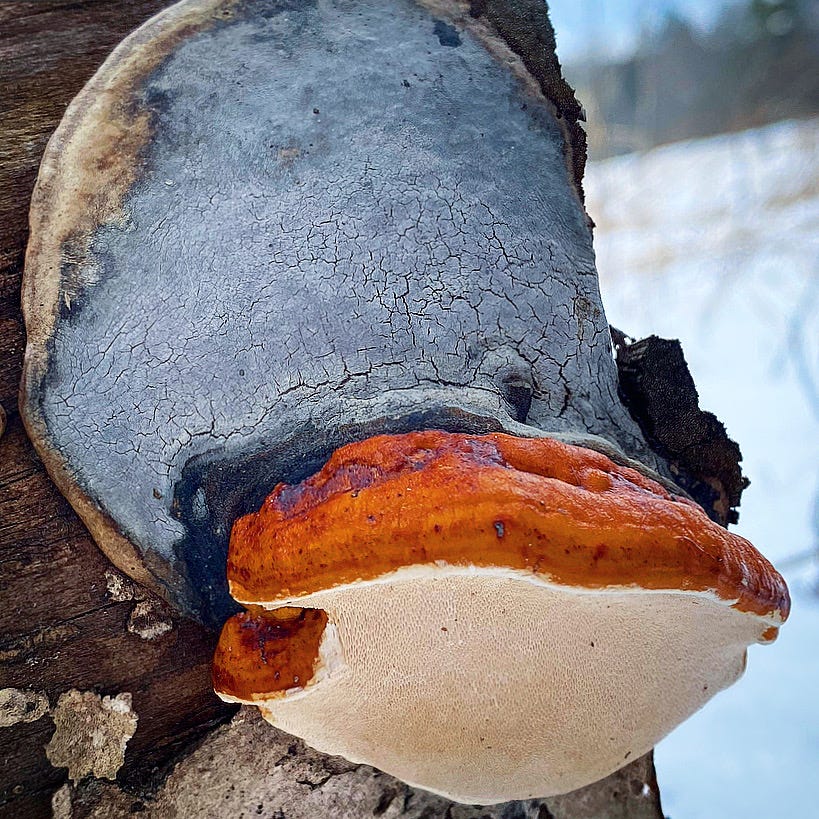
The oldest layer of a rock, or glacier, or soil is the strongest. It’s under pressure. Connected to source. The oldest layer of a tree is the heartwood, the tender potential of the seed made manifest. It is painstakingly built upon, protected at all costs. The oldest layer of a conk mushroom is the root. Tapped in directly to the mycelium. Plugged in to the wisdom. It can return to the source of information to inform its growth. Is there enough nourishment for us to continue to grow? If yes, add another layer. If no, lie in rest.
We seem to have forgotten this simple wisdom. And many of us have lost hope. I’ve been called naïve, overly optimistic for the belief I’ve stated above. It’s a tender spot for me. I’ve developed a hard shell of learned experience to protect my hope. I’ll share it now with you. Here’s what keeps the tinder burning in my heart:
Kokum would get annoyed with the romanticized versions of Indigenous teachings in the world. The noble savage archetype would cause her to make a retching sound in her throat. The idea that all was harmony and balance. She said if you really listened to the stories, of which she told many, you’d begin to notice a pattern.The pattern was this: the people were living out of balance. Nature shifted to remind them of their place. The people were taking too much. Nature withdrew her gifts so we could feel the hard bite of hunger. The people were becoming too many for the land. A long journey would be necessary to find a new home. The people had forgotten how to share. War would break out among the people to remind us of our kinship through the painful lesson of spilled blood.
She reminded us that the people learned to live in balance, by directly experiencing what it felt like to suffer the consequences of living out of balance.
The environmental symbioses so often touted as a birthright to Indigeneity is a learned and taught skill.
We can and must remember the teachings.
How I Met Her
The first time I met her, my mom introduced us in the evergreen woods behind our home. A mighty spruce had been beheaded by a storm a few winters previously. The chilly January of my seventh year on earth found my mom and I squeaking through the fresh-fallen snow to escape cabin fever.
“Look,” she gasped as she crunched towards the fallen crown, “fairie’s balconies”.
I knelt beside her as she rapped on the protruding red and brown striped half-moon.
“This is where the fairies stand to sing their arias”. She smiled, her eyes sparkling.
She stood and swept her hand dramatically toward the canopy singing a Beatles tune in her full contralto.
I remember giggling and stroking the deeply lined surface of the conk in awe.
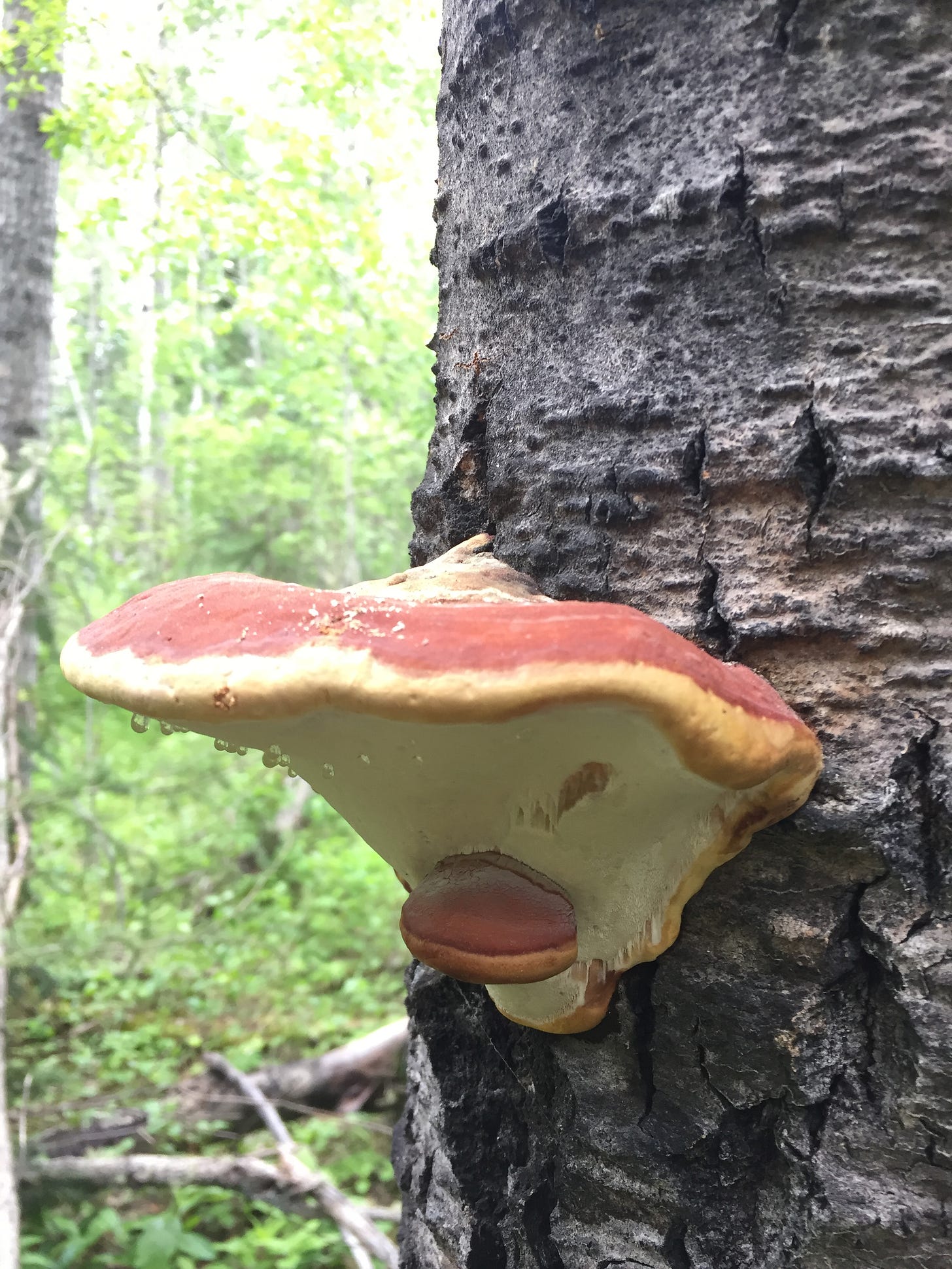
The second time I met her struck a more somber tone.
On a retreat to heal from the lingering grip of addiction, I rent a cabin in the woods near my old home. I tell no-one. In hindsight, an unnecessary risk, but I leave in search of solitude, complete and total.
It snows ceaselessly for the first two days.
The third morning, the sun rises in a clear sky. I strap on my snowshoes and trudge through the fresh snowfall, meandering along game trails that braid their way through the blanketed landscape. The prints of multiple species link together the animal's needs for water, for food, for shelter, the way mycelium links the trees.
As I walk, I ruminate on the ways in which we humans complicate situations. We seek answers where there are only more questions and ignore the answers given to us. We think it can't be that simple: to walk in the woods and find what you need.
Sometimes, it is that simple.
I simultaneously emerge from my musings, and from an endless stand of middle-aged aspen, to find myself in an old selective logging sight. Before massive machines like the feller-buncher came along, trees were logged in selected patches. Larger trees were staked out, hacked so they fell in the desired direction, sawed into manageable sections and hauled out with a team of horses.
Though much more labor intensive, this technique allowed forests to regrow rapidly and kept biodiversity intact. In fact, felling the giant spruce had flooded the forest floor with light over a hundred years ago and the trees that stood in the circle were as varied as the human personalities on a city block. I noted aspen, fir, willow, alder, cottonwood, birch and the offspring of the fallen spruce.
At the edge of the clearing I stop with a jolt. The beheaded spruce reposes in its final resting place, sinking deeper into the soil from which it sprouted. The fairie’s seem to have been busy building condominiums inside it’s body. Their balconies have multiplied. There are now at least twenty jutting from the horizontal trunk.
I knock on the one I met all those years ago. Fifteen years had passed in an instant. An echoing thud and it falls into the snow.
I don’t know why but the sight twists my heart. I crumple. My head in my hands, I sob. Deep, racking sounds that echo alongside the hollow thud of my heart against my ribcage.
I’m deep in the past, remembering all the times I wanted to connect, and didn’t know how. The times I had an anecdote to add to the conversation, and felt it die in my voice box. The times I held out a hand and clasped empty air.
A phrase my counselor used to repeat in treatment:
The opposite of addiction is not sobriety, it’s connection.
Realizing how far I've wandered from my cabin snaps me back to the present. This far north, around the time of Solstice, the sun dances a brief arc across the sky, scarcely glinting above the horizon. Earlier, the sky had been too gauzed over with cloud cover to notice its passage.
Now, it drops low enough to illuminate the underbelly of the clouds. Its light slants sidelong into my eyes. Deep in the cavern of my belly, an ache begins to pulse. A fear - that I'll get stranded outside and die from exposure.
With the sun fully risen, the temperature barely climbs over twenty below Celsius. Overnight, it will drop below thirty for sure.
Alarm bells clang in every nerve ending from my head to my toes. The knocking against my ribcage intensifies. I worry that I’ll pass out. My panic rises like spring rivers filling with meltwater.
This is the feeling that I always try to escape from. The overwhelming emotion that makes me pick up a bottle, a powder, a pill, anything so I don’t have to sit with it.
The sound of running water intrudes on my panic. A spring fed stream that still flows this deep into winter.
I sit beside the water and breathe. Deep. Steady.
I feel the presence of the mushroom. The weight in my hand.
I think of my mom, and suddenly, I miss her so deeply that it aches. I worry I’ll never see her again. She has no idea I’m here, so close to her house. No-one does.
The knocking, which had subsided while I focused on my way forward, increases in tempo and urgency. I feel my temples start to pulse.
In that moment, I realize something that the doctor's could not have guessed. My migraines are triggered by fear. Like the rabbit, I draw my fear to me. I say to myself “What if I cannot...” and then I manifest the conditions under which I cannot accomplish whatever it is that's making me fearful.
I try to breathe deeply, to return to my place of calm. But my scarf cinches too tight around my face. I claw it away from my neck and inhale. I drink the spring water from cupped hands. The cold liquid moves slow and slippery, nipping my hands to a tender pink.
I grasp for another deep breath as the pain increases. In that breath, I inhale a familiar scent.
A smell like cookie dough sitting on the counter, waiting to be plopped onto sheets and slid in the oven.
I dart this way and that among the willows trying to locate the odor. The diamonds watch me, like eyes half closed by sleep.
In the eastern sky, a half moon rises. And on an old and twisted trunk before me, a fungus mimicking the shape pulls me toward it. I press my nose to its flesh. The smell is unmistakable. The hammering fades to a sound like gentle rain.
I cup my hand around the shape, feeling softness despite the bitter cold.
I lean my forehead against the back of my hand and feel a gentle pull, a cracking sound as she departs readily from the tree where she's grown for decades. Two mushrooms have offered their flesh to me today. As medicine.
Gratefully, I drop to my knees and fumble in my pockets for a knife. I slice off little pieces from each mushroom and crumble them between my fingers. I pack them into the little glass pipe that used to help me escape reality. In this moment, I hope, it will bring me back to my body.
I hold the flame to powder for a second and it leaps into a glow.
The smoke fills the forest, my lungs, my heart, my vision, and my head feels light and clear, like spring water. My heart slows to an undulating rhythm, pumping oxygenated blood to my stricken cells as I breathe deeply.
Diamond willow for my headache. Red belted polypore for my aching heart.
The feeling I run from is still with me. But I can sit with it. It walks beside me as I move through the darkening forest. But it doesn’t dog my footsteps and pant its hot breath on the back of my neck.
Healing happens slowly, and in strange, secluded places.
I think I'll go see my mom tonight. I'm so close to home.
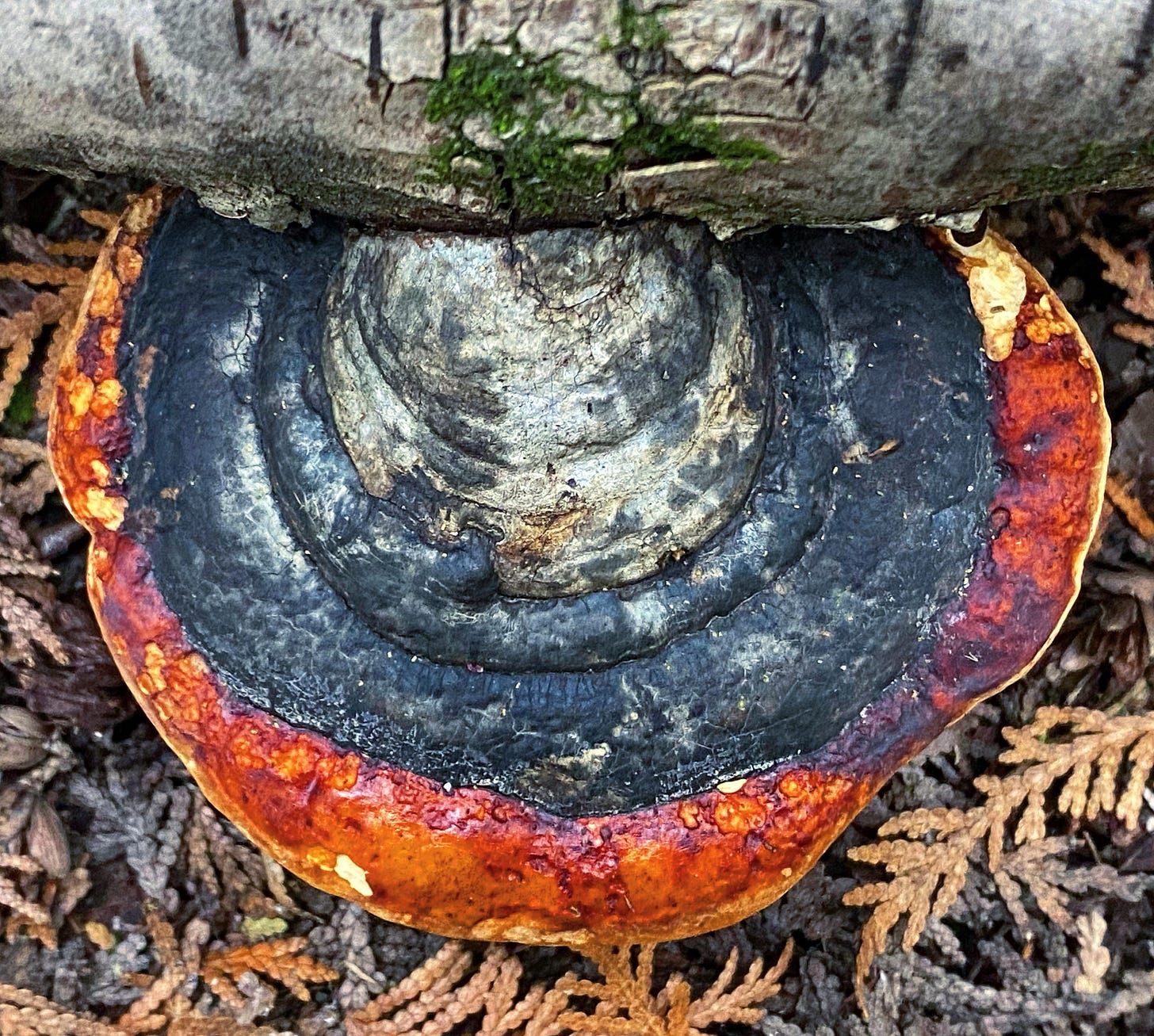
The Heart of the Matter
Now we get to the meat of why this mushroom deserves her own chapter. The impressive array of potential medicinal applications this beating heart of the forest offers to her human kin.
Among her many charms, she can regulate blood sugar, support absorption and elimination, reduce menstrual cramping and headaches, reduce digestive inflammation and improve immune function.
Practitioners have found her specifically skilled at targeting inflammation in the gastrointestinal tract, hence why it’s being investigated for fungal support in treatment of Crohns and IBS. Soothe those guts!
This last one is why I consider this conk the heart of my personal medicine practice. Taken as a tonic, she promotes vasorelaxation, to support those suffering from circulatory disorders. Red belted is even being studied for a role in stroke and blood clot prevention.
Through winter I struggle with decreased circulation referred to as Raynaud’s disease. Headaches are common. My fingers and toes get cold and won’t warm up. They even turn purple in extreme flare-ups. It’s freaked me out a few times. I thought I had frostbite! These days, as soon as the temperature drops below zero, I have a pot of red belted and chaga simmering at all times.
Like many mushrooms, and especially most polypores, she holds high amounts of polysaccharides. These are known to hold anti-tumor, anti-inflammatory and anti-bacterial benefits.
There’s active research around this practical, and even life-saving mushroom as we slowly conquer our fear of fungus in the Western world. So don’t take my word for it, do a bit of digging on your own to discover all the wonders these gems of the forest can offer.
For many long years in other medicinal modalities, she has been used to “move fire” not only as a fire-keeper between camps, but in the body. That fire red hue should signal to us that she operates in the fire element. Fire being the blood and oxygen that circulates in our veins, and the body’s ability to convert food into energy through digestion.
As mentioned, First Nations have used it for centuries for carrying the fire. But her relationship with them doesn’t stop there. They used dried powder to stop the flow of blood from a wound. Or mixed it with tobacco and smoked it to cure headaches and relieve pain. The tea can be quaffed as a mild pain reliever.
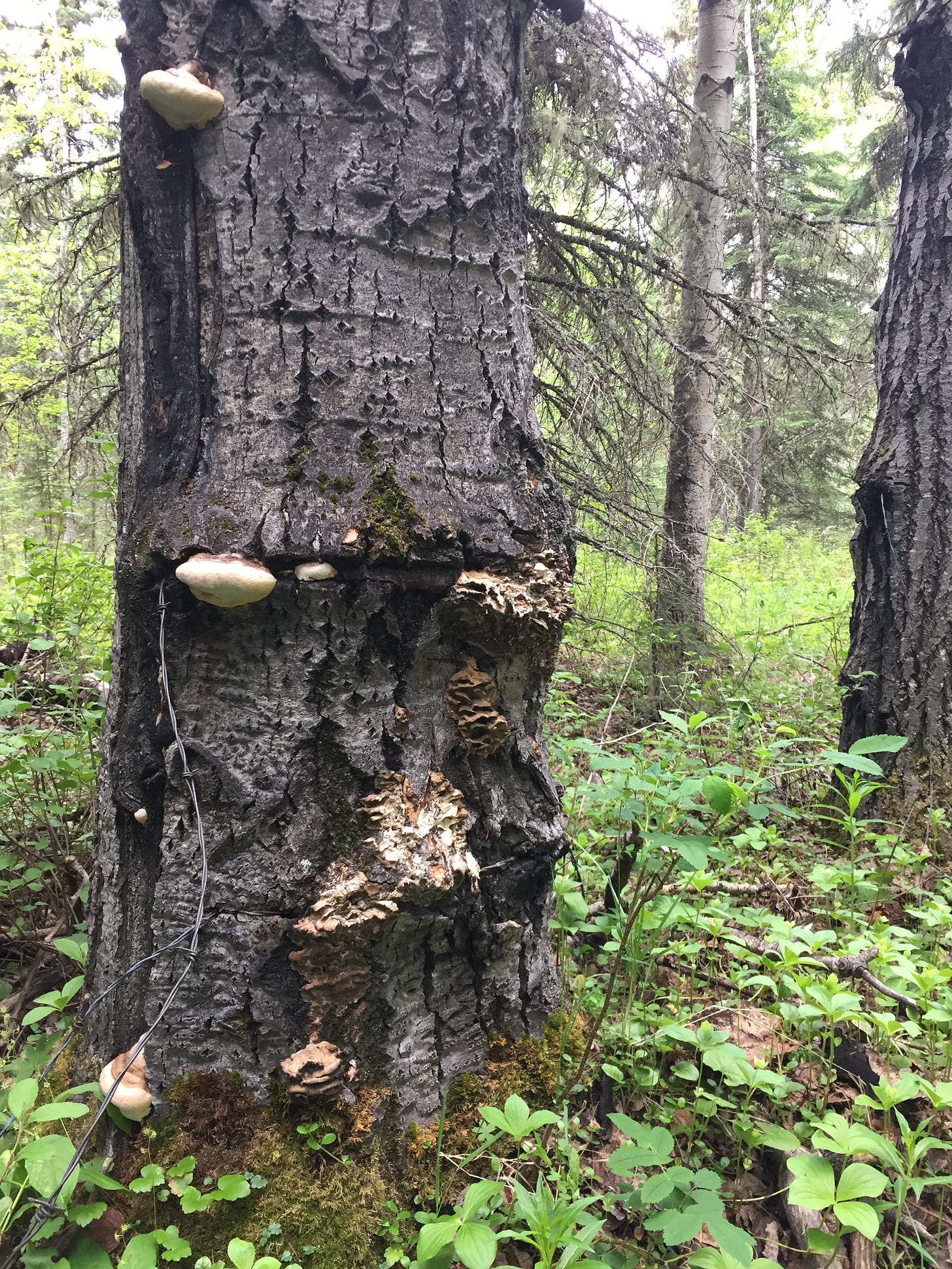
How You Can Meet Her
Put on your favorite album and play it loud. Sing at the top of your lungs. Drive out of the city, towards any conifer forest you know in the area. Strap on your snowshoes. Strike off in any direction. Follow your heart.
Enjoy the stark beauty of the forest stripped of leaves, washed of all color. And then start to notice the more subtle colors, harder to spot when your eyes are saturated with the vibrant greens of summer.
The bluish hue of the snow. Ice crystals glistening iridescent on willow branches. Crisp lichens in oranges and pale greens. Burnished gold of spent grasses. Sage green of dried artemisia, power blue juniper, and the glossy emerald of kinnikinnik and oregon grape. And then red. It will draw your eye like spilled blood. You won’t be able to look away.
You’ll notice it everywhere. Rosehips and high bush cranberry, the rich ruby of star-flowered solomon’s seal berries, hawthorn fruits glowing ruddy in the low sun, the sanguine stripe of vital new shoots from the hearts of dogwood bushes.
There on the fallen spruce, the unmistakable maroon tinged with burnt orange. The curved crescentiform emerging from a spruce with a dead top.
How to Know if You’ve Met Her
The young mushrooms resemble little white buttons on a tree, often with dew drops of guttation clinging to them. As mentioned, she’s perennial and sprouts a fresh pore surface each year. Essentially, a new mushroom grows around the old one. It forms a distinct red band with each passing year, which is how it gets its name. The band exists in the strata between the tender new growth and the old layers. Brown or grey on top, red or orange in the middle and creamy white on the bottom.
Eventually, with several seasons under its red belt, the fruiting body may begin to resemble a thick hoof — this never happens with reishi. If you’re still unsure, flip the specimen over and scratch the pore surface. A reishi stains brown when bruised, while a red-belted conk doesn’t stain at all.
Sometimes older specimens can resemble artists conk. It’s not a dangerous misidentification, but if you want to be sure, the scratch test can work for this distinction as well.
If you’re sure you’ve found one, the best way to dislodge is to slide a knife between the bark and the fruit and to apply slight downward pressure. Try to break off as little of the substrate as possible. For utmost ethical harvesting, you can simply slice away the outermost pore layer from the more mature conks. They will quickly regrow.
How to Prepare
Confusingly, many guide books simply list this polypore as inedible. This denies the rich medicinal properties held within her woody fibres. While it’s true that texturally, gnawing on her backside wouldn’t be very pleasing, there are other ways to access her nourishment.
I slice the whole mushroom into ¼” thick strips. Think stir fry beef thick. Drying them in the sun will store more Vitamin D in the mushroom flesh. A dehydrator works well too.
Dry or fresh strips can be made into a tea. Boil water, add mushrooms. Reduce to simmer. Add spices as desired, but delicious as an earthy mushroom beverage too. Enjoy your tea when the color has deepened to a lush burgundy-brown. The slight bitterness can be eased by adding honey.
You can also add the dried strips or powder to soup broth. Simmer for one hour and then craft your soup with much added nutritional value. A bonus is that it adds flavour and acts as a natural preservative, for peace of mind in those times when you forget to put the leftovers in the fridge.
The most widely recommended preparation is the double extraction, which is a decoction and a tincture. This is to capture both water and alcohol soluble constituents.
Here is a recipe for making a dual extract:
1:20 dried mushroom : water (1oz mushroom: 560ml Water)
Simmer until liquid is reduced by half (280mL)
Let cool, and pour mushroom and water into sanitized jar
Add 95ml 95% alcohol (you want about 30% ETOH)
Shake daily and let macerate for 3 weeks
Strain out and you have a dual extract!
Source: https://ultimate-mushroom.com/edible/62-fomitopsis-pinicola.html
Red Belted Conk — Hearthside Healing
Fomitopsis pinicola – reishi and roses
Fomitopsis pinicola: The Ultimate Mushroom Guide + 2 Recipes
*Kokum is Cree for Grandmother. Kokum here refers to my best friend’s grandmother who took me under her wing as a young one. She is mentioned in the Introduction and re-appears throughout many narratives as she introduced me to an immeasurable amount of wisdom. She spoon fed it to me thru the natural world. And I will trickle it into my writing to keep it alive.






A Truly beautiful entry in this magical tome!
Thank you lovely!